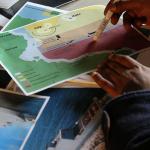Abstract
Drawing on the research conducted within the Forensic Oceanography project, this presentation will analyse the form of indirect violence operating at the EU’s maritime frontier, and underline the ambivalent role played by the geophysical environment. The sea’s “geopower” (Grosz) has been made to oscillate between a medium enabling migrants’ movement despite the denial by European policies to access safe means of transport, and constituting a threatening liquid mass that risks swallowing their lives at any moment. Water then has been turned by European policies into a hostile environment, that mediates between state policies of exclusion on the one hand, and the bodies and lives of migrants on the other. The liquid violence exercised at the maritime frontier has cost the lives of more than 30.000 migrants since the end of 1980s. Forensic Oceanography’s aim has been to trace the shifting modalities of liquid violence, attending to the changing practices of actors at sea and policy shifts. The presentation will further point to current research directions: on the one hand the possibility of adapting the critical forensic methods to other areas of mobility conflicts – such as the Alps and the Sahara; on the other of mapping the broader web of relations within which mobility conflicts are embedded so that these can be transformed and de-escalated.
Charles Heller is a researcher and filmmaker whose work has a long-standing focus on the politics of migration. In 2015, he completed a PhD in Research Architecture at Goldsmiths, University of London. He is currently based in Geneva, where he is a Research Associate at Graduate Institute’s Centre on Conflict, Development and Peacebuilding. Together with Lorenzo Pezzani, in 2011 he co-founded Forensic Oceanography, a collaborative project that critically investigates the militarized border regime in the Mediterranean Sea, as well as the WatchTheMed platform. Together with a wide network of NGOs, scientists, journalists, and activist groups, he has produced maps, video animations, installations and human right reports that attempt to document and challenge the ongoing death of migrants at sea. His work has been used as evidence in courts of law, published across different media and academic outlets and exhibited widely.




